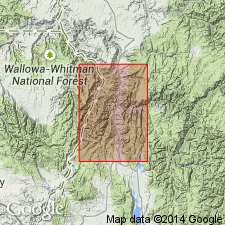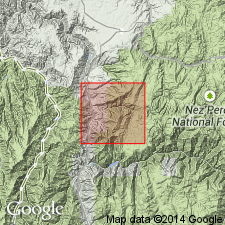
- Usage in publication:
-
- Fiddle Creek Schist*
- Modifications:
-
- Named
- Dominant lithology:
-
- Schist
- Amphibolite
- AAPG geologic province:
-
- Idaho Mountains province
Summary:
Named as one of four newly named formations and the structurally lowest formation of Riggins Group (new) for exposures along Fiddle Creek, a tributary of the Salmon River, T24N, R2E, Idaho Co, ID, Idaho Mountains province. Also exposed discontinuously along Salmon River. Type section is along Fiddle Creek and ridge to north. Outcrops generally poor. Lower contact is a structural contact. Is separated from Martin Bridge Limestone by Rapid River thrust. Is overlain by Lightning Creek Schist (new) of Riggins Group. Estimated to be 9,000 ft thick. About half of the formation is silicic tuff metamorphosed to white schist that probably originated as crystal and lithic tuffs or as porphyritic flows. Green metavolcanic schist (colored by prochlorite) that ranges from schistose to massive is next in abundance. Chloritic hornblende schist distinguished by large prisms of hornblende in a finely schistose greenish-gray groundmass is interlayered with other rock types. Greenschist gives way eastward, the direction of increasing metamorphic grade, to green amphibolite. Hornblende-rich schist present in east part of area. Formed from massive tuffs and flows of intermediate and silicic composition. Shown as Paleozoic or Mesozoic age on geologic map. Is older than Idaho batholith. Could be correlated with rocks that range from Cambrian through Early Cretaceous.
Source: GNU records (USGS DDS-6; Denver GNULEX).

- Usage in publication:
-
- Fiddle Creek Schist
- Modifications:
-
- Not used
Summary:
Some medium- and high-grade metamorphosed volcanic rocks mapped east of the Salmon River area are mapped as metamorphic units whose relative age and correlation are unknown; these rocks are tentatively correlated with the Seven Devils Group; they are shown as Permian and Triassic age; they are also mapped as present in two plates--the Rapid River and North Fork plates--of the Wallowa terrane. These metamorphosed rocks were previously assigned to formations of the Riggins Group. There is no evidence found during this study to indicate that rocks of the Riggins and the Wallowa are different island arcs. Also, all identifiable map characteristics useful for distinguishing the formations have been obliterated by multiple episodes of metamorphism and deformation. The mapped units cannot be correlated with or assigned to individual formations with confidence. Therefore, the name Riggins and its component formations are not recognized in this study.
Source: Modified from GNU records (USGS DDS-6; Denver GNULEX).
For more information, please contact Nancy Stamm, Geologic Names Committee Secretary.
Asterisk (*) indicates published by U.S. Geological Survey authors.
"No current usage" (†) implies that a name has been abandoned or has fallen into disuse. Former usage and, if known, replacement name given in parentheses ( ).
Slash (/) indicates name conflicts with nomenclatural guidelines (CSN, 1933; ACSN, 1961, 1970; NACSN, 1983, 2005, 2021). May be explained within brackets ([ ]).

